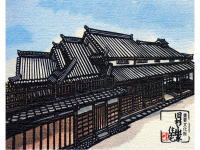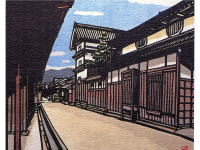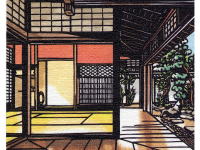富田林寺内町の探訪
I'm glad to intorduce an old town, Jinaimachi, Tondabayashi, Osaka, Japan as a national historic district and heritage site.
It takes 30 minutes from Osaka city to Tondabayashi station by Kintetsu railways. A 10-minutes walk will take you to the historic town.
ギャラリー
Jyounomonsuji Street, the 100 selections of roads in Japan
| 【Tourist guide to Jinaimachi town, Tondabayashi, a historic district and heritage site of Japan, Jyounomonsuji Street】 | ||||
 jyounomonsuji street and Jinaimachi town scaping ( provided by Tondabayashi Municipality, unauthorized copying and replication are strictly prohibited.) |
||||
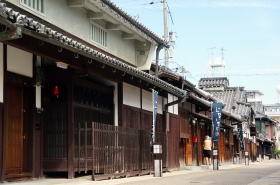 |
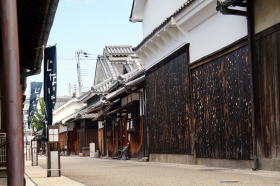 |
|||
| Jinaimachi town in Tondabayashi, where a large number of old wooden residences
of merchants in the Edo era (1603-1868) still remain. The Jyounomon-suji
street north to south through the center of town, approximately 400 meters’
distance, was chosen as "the 100 selections of roads in Japan"
by commemorating the 10th August of the Day of roads in 1986. The name of Jyounomon-suji street, which literally means the street in
front of the gate of castle, has been derived from the fact that the main
gate of Koushouji Betsuin Temple facing the street in the center of town,
is said to be removed and rebuilt from that of Fushimi castle
Hideyoshi Toyotomi constructed in Kyoto. The academic investigation of
2012 confirmed that the gate was constructed in the Azuchi-Momoyama period,
approximately 1558-1600, which is more likely considered as the remains
of Fushimi castle, and it was re-relocated from the head temple, Koushouji
Temple in Kyoto, to Jinaimachi, according the record. |
||||
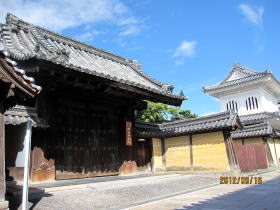 Koushouji Betsuin Temple Temple gate and Drum Tower |
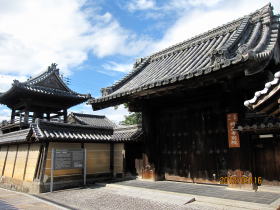 Koushouji Betsuin Temple Temple gate and Bell Tower |
|||
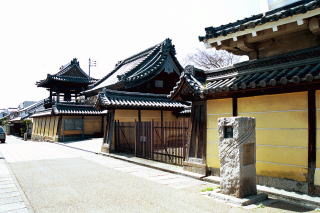 Koushouji Betsuin Temple and Memorial Monument of the 100 selections of roads in Japan |
 Memorial Monument of the 100 selections of roads in Japan |
|||
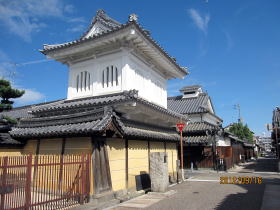 Koushouji Betsuin Temple and Drum Tower |
||||
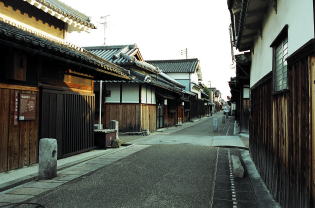 Tomiyama-cho |
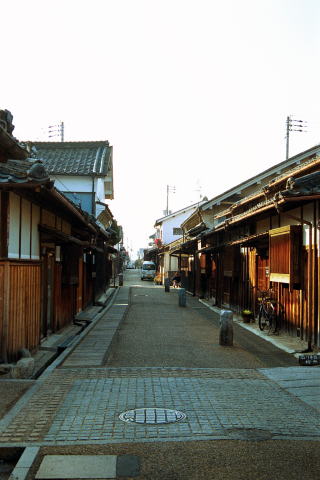 Turning to the south derection Looking towards Tondabayashi Gobo (Koushouji Betsuin Temple) from Tomiyama-cho |
|||
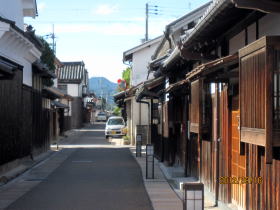 Turning to the south derection Looking towards Tondabayashi Gobo (Koushouji Betsuin Temple) from Tomiyama-choand Dake mountain is seen in the center. |
||||
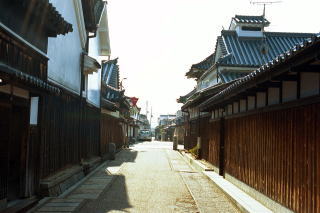 South Kiasho-cho |
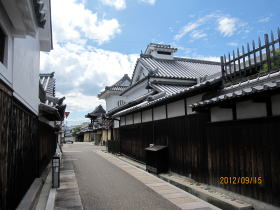 South Kiasho-cho |
|||
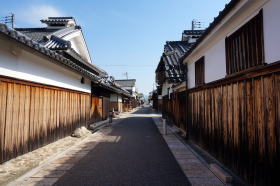 Ichiriyama-cho |
 Gobo-cho(Myoukeji Temple) |
|||
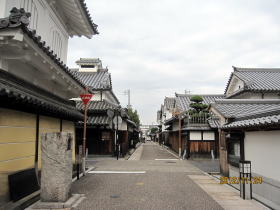 |
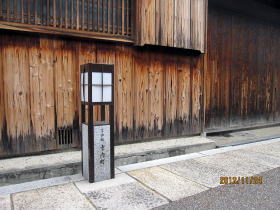 The street is lighted up by lamps placed in a row on the road a street at night. |
|||
| Atemage-no-Tsuji (literally means “the road struck and bent”) The streets in the town area are laid out in a grid running north-south and east-west, and the original town planning has been left at present. For the security reason, the two streets crossing at right angles were slightly deviated on purpose, then the structure made it difficult for foreign enemy who invaded the town to foresee straight a distant place. The structure was often seen in castle towns at that time. |
||||
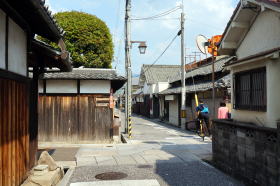 North Kaisho-cho・Atemage-no-Michi |
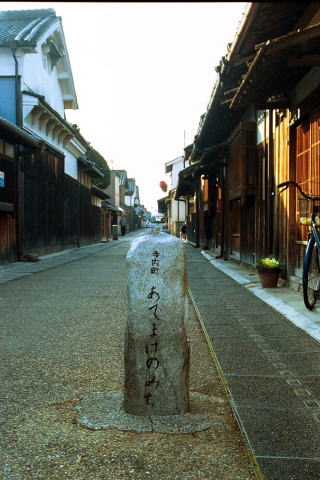 A stone signpost of「Atemage-no-Michi」 and Youjin-Bori , a culvert on the right |
|||
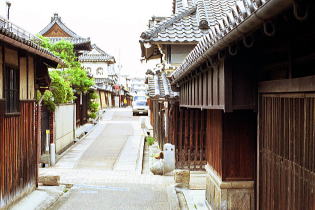 Hayashi-cho・Atemage-no-Michi |
||||
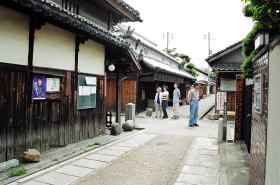 |
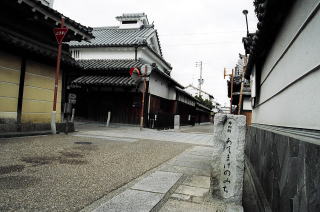 Sakai-cho(Sakai-suji Street) |
|||
| Youjin-Bori (Ditch for firefighting water) Youjin-Bori literally means a ditch of precautions against fire. A moat of precaution (a culvert) is placed along the Jyounomonsuji street, and the stone bridge across the moat is named as Gan-ei bridge, praying for the prosperity of Iwase-ya forever. |
||||
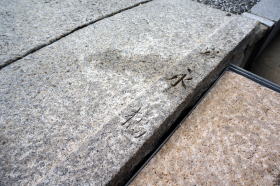 Gan-ei bridge across Youjin-Bori(Tomiyama-cho) |
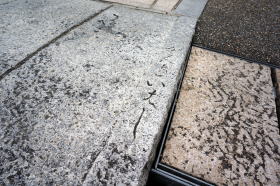 Gan-ei bridge across Youjin-Bori(Tomiyama-cho) |
|||
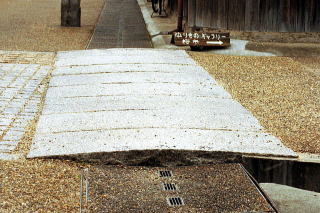 Gan-ei bridge across Youjin-Bori(Tomiyama-cho) |
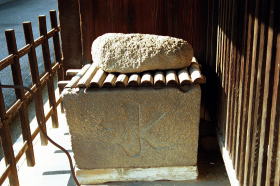 stone-made water tank for fire prevention |
|||
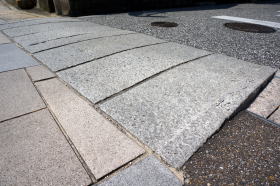 North Kaisho-cho and Youjin-Bori(Furuteya Bridge) |
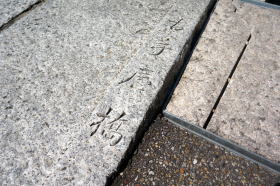 North Kaisho-cho and Youjin-Bori(Furuteya Bridge) |
|||
| Sewari-suiro - waterways of drainage | ||||
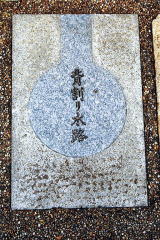 A stone signpost of "Sewari-suiro" placed on the surface of street |
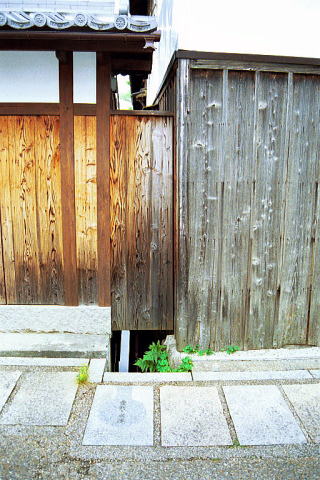 As a boundary of residents’ premises, the waterways of drainage called Sewari-suiro separate blocks of the town |
|||
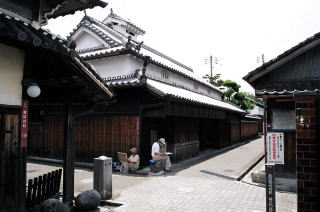 Visitors enjoying sketching(Hayashi-cho) |
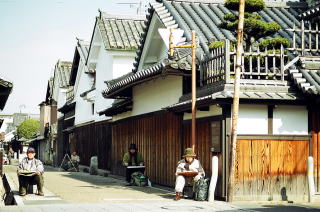 Visitors enjoying sketching(Sakai-cho) |
|||
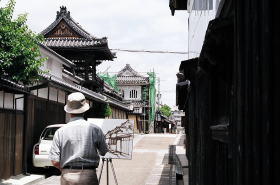 Visitors enjoying sketching(Hayashi-cho) |
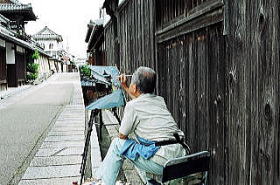 Visitors enjoying sketching(Hayashi-cho) |
|||
| Light up | ||||
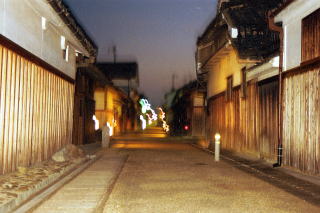 Light up・Tomiyama-cho |
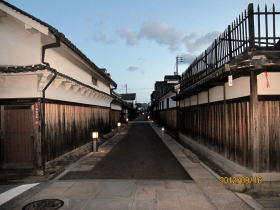 |
|||
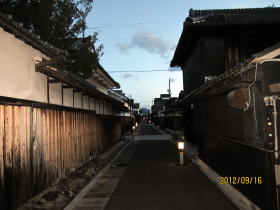 The street is lighted up by lamps placed in a row on the road a street at night. |
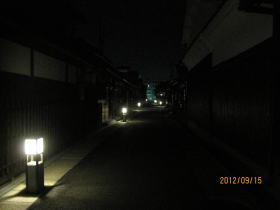 The street is lighted up by lamps placed in a row on the road a street at night. |
|||
|
||||
Information

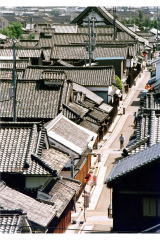
Jinaimachi in Tondabayashi(Jyounomon-suji street)
Photo: provided by Tondabayashi Municipality, unauthorized copying and
replication are strictly prohibited.
Location
Jinaimachi town, Tondabayashi city, a national historic preservation district
and heritage site of Japan, which is located in the south-eastern part
of Osaka prefecture, the western part of Japan
Atemage-no-Michi
(literally means “the road struck and bent”)
Jinaimachi town of Tondabayashi was originally developed as a religious
mission town with autonomy during the age of provincial wars in Japan,
approximately 1467-1590.
The streets in the town area are laid out in a grid running north-south
and east-west, and the original town planning has been left at present.
For the security reason, the two streets crossing at right angles were
slightly deviated on purpose, then the structure made it difficult for
foreign enemy who invaded the town to foresee straight a distant place.
The structure was often seen in castle towns at that time.
(Ditch for firefighting water)
Youjin-Bori literally means a ditch of precautions against fire.
The town is located at the hilltop of river terrace of Ishikawa River.
Therefore, water supply was insufficient, and the residents of the whole
town had extremely paid attentions on the prevention of the fire. There
are ditches keeping firefighting water called the Youjin-Bori in Ichiriyama-cho
and Tomiyama-cho in the north as well as the stone signpost at the entrance
of town, describing the cautions that visitors are not supposed to walk
around in smoking and to carry a cord being ignited in the town. Those
facilities are understood for the residents to have protected the town
for a long time, considering mutual benefit and prosperity of the community.
Such considerations might be one of the reasons why the old townscape was
left and preserved as it used to be.
Sewari-suiro
Jinaimachi Toro
The summer street lantern festival in Jinaimachi.
In the evening of last Saturday in August every year, approximately 1,000
lamps with a paper shade are displayed on both sides of the street of the
Jinaimachi town and are lighted all at once. Many visitors come on that
day and it is very popular as a local summer event. It is jointly organized
by the local association for preservation and development of the town.
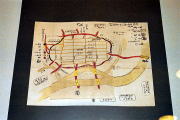
Town Planning
The town was developed in all directions around Koushouji Betsuin Temple
or Tondabayashi Gobo, laying out the grid-shaped town plan with seven streets
called suji and eight avenues called cho. Suji runs north to south and
Cho runs east to west.
The seven streets of suji are, in order from east to west, Higashi-suji,
Kamegasaka-suji, Jyounomon-suji, Tomi-suji, Ichiba-suji and Nishi-suji.
The remaining suji was a little narrower in width than the others and its
trace and name was disappeared.
The eight avenues of cho, in order from north to south, are ichiriyama-cho,
Tomiyama-cho, Kita Kaisho-cho (north Kaisho-cho), Minami Kaisho-cho (south
Kiasho-cho), Sakai-cho, Gobo-cho, Nishi Hayashi-cho (West Hayashi-cho)
and Higashi Hayashi-cho (east Hayashi-cho). Hayashi-cho was divided into
the east one and the west one during the period of 1753-1778 and then the
town has eventually consisted of six streets of suji and eight avenues
of cho.
It is a 10-minute walk from the Tondabayashi Staion or the Tondabayashi
Nishiguchi Station of Kintetsu Nagano line.
From Kansai International Airport
Airport Limousine Bus service available bound for Kawachi Nagano Station.
(60 minutes) Please take Kintetsu railways from Kawachi Nagano to Tondabayashi.(15
minutes)
From Osaka International Airport (Itami Airport)
Airport Limousine Bus service available bound for Abenobashi Station. (30
minutes) Please take Kintetsu railways from Abenobashi terminal to Tondabayashi.(30 munites)
From JR Shinkasen Shin-Osaka station or
Osaka (Umeda) station
Please take Subway Midousuji line from Shin-Osaka station or Osaka (Umeda)
station to Tennoji Station. (20~30 minutes) Please change trains at Tennoji
and take Kintetsu railways from Abenobashi terminal to Tondabayashi. (30
minutes)
The site-seeing map available in English
Please stop by to the Tourist Information Cetnter or Jinaimachi Visitor
Center.
Restrooms
Available at Jinaimachi Visitor Center (Jinaimachi Kouryuukan), Jinaimachi
Center and Jinaimachi Tenbou Hiroba (Viewing Terrace)
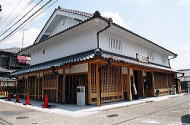
Visitor Center
(Jinaimachi Kouryuukan,
Town Community Center)
Address
9-29, Tondabayashi-cho, Tondabayashi city, Osaka, 584-0033, Japan
TEL.+81-(0)721-26-0110
FAX.+81-(0)721-26-0110
open 10a.m. until 5 p.m.
closed on Monday
Visitor Parking
Road width is very narrow in Jinaimachi town. If traveling by car, please
use Tondabayashi Municipal east parking newly opened in February 2014 (Toll
parking).
You can park the minibus for groups and passenger cars for general use.
Only one parking lot available for minibus, you must book it in advance
with Tondabayashi City Hall. A 15-minute walk to the Jinaimachi Visitor
Center and 5 minute walk up to the former Sugiyama family house, an important
national cultural property.
You will note that you will contact Tondabayashi Municipality Office for
a parking lot of large tourist bus for groups. Thank you in advance for
your kind cooperation.
